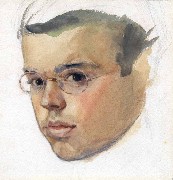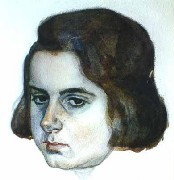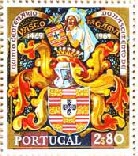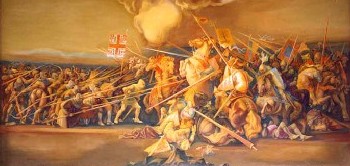
|
 |
| Self-portrait
(ca 1918) Watercolor on paper Private collection |
Màmia Watercolor on paper Private collection |

Portuguese painter and scholar
(1899-1970)
Jaime Martins Barata was born on March 7, 1899 in Alentejo, Portugal. He grew up in Póvoa e Meadas, a small village not far from the Spanish border. His father, José Pedro Barata, was superintendent at a rural estate; his mother, Antónia de Jesus Martins, a primary-school teacher. In 1904, José Pedro Barata died, survived by his wife and two sons. Despite the significant financial strain, Antónia Martins Barata managed to put her children through high-school; and, seeing their good academic performance, later decided to move to Lisbon, where they would continue their studies.
From very early on, Jaime had a great variety of interests and was unsure what course of studies to take. He first enrolled in the Escola Normal Superior with a view at becoming a mathematics teacher. For a while, he also studied economics in the Escola Superior de Comércio. But the idea of becoming an economist never really attracted him, and he went back to the initial plan of being a school teacher. From 1922 to 1947, he taught arts and mathematics at some of Lisbon’s leading highschools.

|
 |
| Self-portrait
(ca 1918) Watercolor on paper Private collection |
Màmia Watercolor on paper Private collection |
As a teenager, Jaime was already an accomplished watercolor painter (see Early works), though he considered painting to be a hobby rather than a professional career. It was with this spirit that, while studying to become a teacher, he frequented the halls of the Sociedade Nacional de Belas-Artes, Portugal’s leading arts society. Here he was introduced to a truly remarkable generation of artists--painters, sculptors, architects--with whom he would share his interests in painting (see A generation of artists). Some of these acquaintances would later lead to professional collaborations and liefelong friendships. Martins Barata's "best pal" was José Manuel Leitão de Barros. The two amateur watercolor painters would eventually marry two sisters, Màmia (see picture above) and Helena, who happened to be daughters of Roque Gameiro and also watercolor painters!
One of the first collaborations among the group of young artists was a series of illustrated magazines (ABC, ABCzinho, Notícias Ilustrado), where Jaime worked on a part-time basis as photojournalist and illustrator. His work as an illustrator would continue throughout the years, including books of important historic and documental interest (see Selected works).
1940 was the year of the Portuguese World Expo. This was a major event not only in Portuguese politics but also in Portuguese art: under the direction of Cottinelli Telmo, a great number of artists--by and large with little regard to their political leanings--collaborated in this great project. Martins Barata was invited to paint a series of large panels representing scenes from the history of Portugal. This would be the first of a long series of large-scale paintings, initially in the oil medium and later, beginning with Rome’s St Eugene basilica, in the fresco technique.
The Portuguese World Expo was also the occasion for another new line of artistic creation: Martins Barata was invited by the Portuguese Post Office to design a commemorative stamp of the event. Following this, a number of other stamp design projects would be commissioned (see Stamps, notes and coins). Some years later (1947) Martins Barata was appointed art consultant to the Portuguse post office, a position he would occupy until his retirement.
 |
Commemorative stamp of the 500th anniversary of the birth of Vasco da Gama (1968) |
With this appointment and the increasing number of large-scale paintings he was commissioned, Martins Barata abandoned his career as school teacher--and also reduced the time dedicated to watercolor painting. He now spent much of his time learning and perfecting the different techniques and mediums required for his new line of work. The price of this effort was that, aside for the works he was commissioned, his painting output was relatively scarce (save for a number of incomplete studies, sometimes repetitions of the same study).
Large-scale painting, one may argue, constitutes the core of Martins Barata’s ouvre as a painter. Most of these works were commissioned by the government and destined to public buildings: courts of justice, government ministries, and so forth. Also, most of them were fresco mural paintings. The problem with this, of course, is that they are geographically dispersed and not easily accessible. This accounts, at least partly, for the fact that the work of Martins Barata is less known than its quality and importance would justify.
 |
The Battle of Atoleiros (1966) Buon fresco Fronteira court of justice |
Although teaching and painting were his main professional occupations, Jaime Martins Barata was a man of many interests and talents. Anyone who would visit his studio (a large, three-story-high buiding) would come across inumerous mechanisms, objects and gadgets he invented or perfected in order to facilitate the task of painting large sufaces (or for other purposes). He was a very practical, ingineous person.
Several other examples could be given of the variety of Martins Barata’s contributions. For example, beginning in the 1930s and until the end of his life, he actively participated in the historical debate over the transition to the Portuguese caravel of the 15th Century, the ship that would revolutionize ocean navigation.
In summary, more than just a painter, Martins Barata was a true Renaissance man!